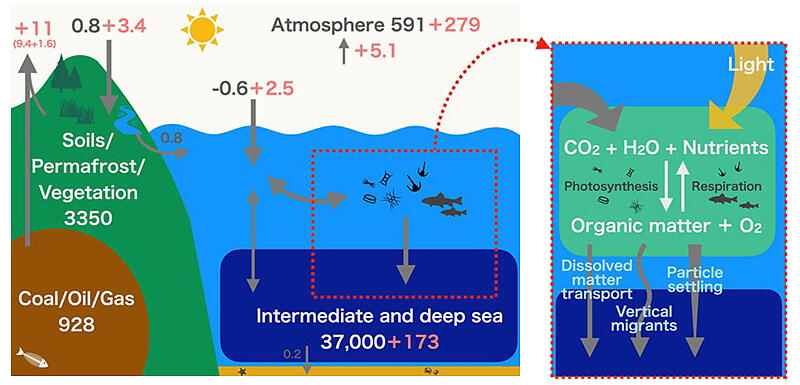A research group led by Researcher Ryohei Yamaguchi and Senior Researcher Shinya Kouketsu at the Global Ocean Observation Research Center, Research Institute for Global Change, Japan Agency for Marine-Earth Science and Technology (JAMSTEC), in collaboration with the Japan Meteorological Agency's Meteorological Research Institute, has announced that they determined the spatial distribution and total amount of carbon dioxide absorbed annually by biological activity in the ocean, using dissolved oxygen data observed and recorded in the ocean around the world. The carbon dioxide absorption through biological activity in the ocean (the biological pump) was estimated to be about 7.4 billion tons of carbon per year, indicating that previous estimates may have been overestimated. The findings are expected to lead to improved accuracy in future climate prediction. The results were published in the December 16 issue of the international journal Communications Earth & Environment.

Provided by JAMSTEC
The ocean acts as a huge carbon reservoir, absorbing carbon dioxide and sequestering it from the atmosphere. Through these functions, the ocean prevents excessive warming and provides a viable climate for humans. The biological pump via activity is one mechanism for this absorption and sequestration. Meanwhile, the CO2 fixation via photosynthesis by phytoplankton, which constitutes the biological pump, and the carbon transport pathway of the fixed carbon to the lower layers are extremely complex and diverse and thus difficult to measure directly. The values obtained by intensive direct observation using sediment traps and other means at a limited number of observation points are extrapolated to estimate global values. Therefore, although there are many reports, estimates of total carbon transport vary from 4 to 13 billion tons of carbon per year, highlighting high uncertainty.
The research group focused on the relationship, indicating that oxygen production is almost constant when CO2 is fixed through photosynthesis by phytoplankton in the ocean surface layer, in which sunlight is available. The amount of fixed CO2 was calculated backward from the amount of oxygen produced by organisms. Dissolved oxygen concentrations in seawater have been observed and recorded by research institutions around the world using marine vessels since around the 1980s, and JAMSTEC has contributed to these observations.
Recently, automatic observation floats equipped with dissolved oxygen sensors have been deployed and were shown to have recorded and accumulated data in almost all ocean areas, covering about 90% of the globe.
The group used these data to accurately calculate the physical processes (air-sea exchange, horizontal and vertical advection, and horizontal and vertical diffusion) involved in the variability of dissolved oxygen, considering the ocean surface layer at a certain location as a single box. By subtracting the amount of oxygen consumed through respiration from the amount of oxygen produced through photosynthesis by phytoplankton, they successfully calculated the annual amount of oxygen produced by biological activity for the global ocean. This value was converted to an annual organic carbon production, indicating that estimated 7.4±2.1 billion tons of carbon is taken up by the ocean through the biological pump.
Yamaguchi said, "Moving forward, I would like to work on future changes in the biological pump and their impact on the climate, as well as a more detailed understanding of the biological pump processes. This study has just revealed the current state of the biological pump, and we do not know if the value reflects the effects of climate change or is a constant value for the Earth system. To keep a close eye on this, I believe it is important to maintain and develop our current observation system."
Journal Information
Publication: Communications Earth & Environment
Title: Global upper ocean dissolved oxygen budget for constraining the biological carbon pump
DOI: 10.1038/s43247-024-01886-7
This article has been translated by JST with permission from The Science News Ltd. (https://sci-news.co.jp/). Unauthorized reproduction of the article and photographs is prohibited.




